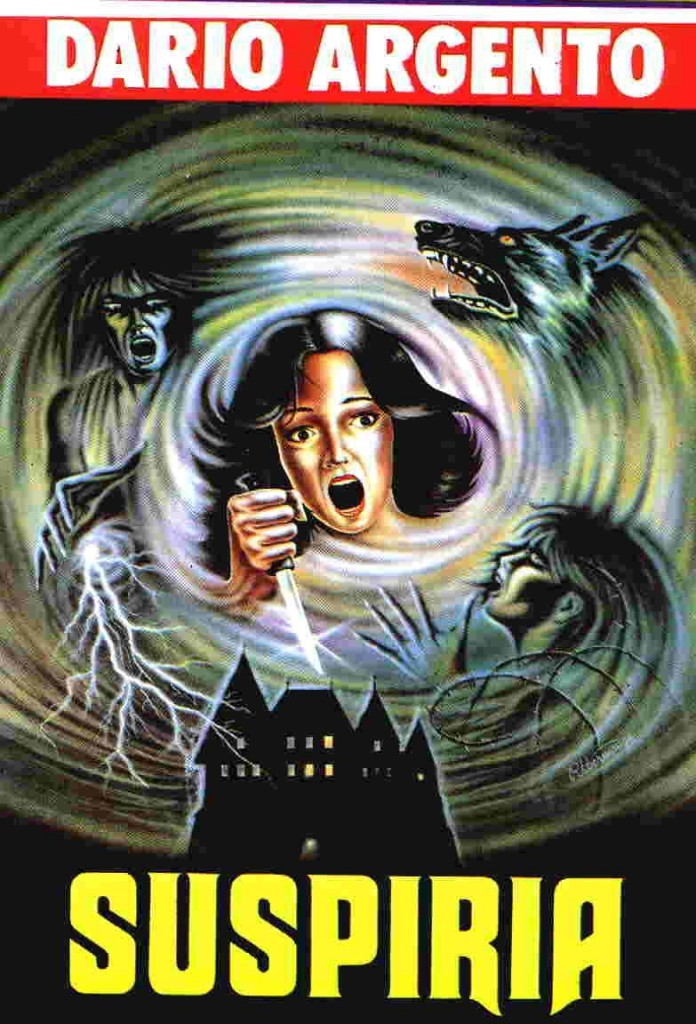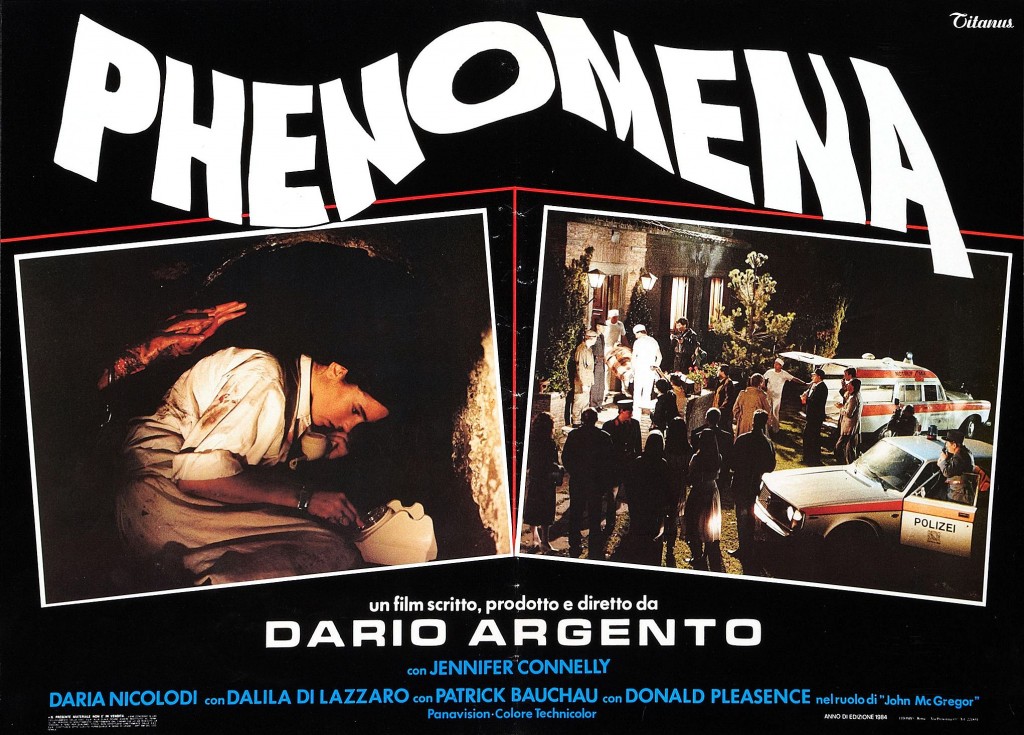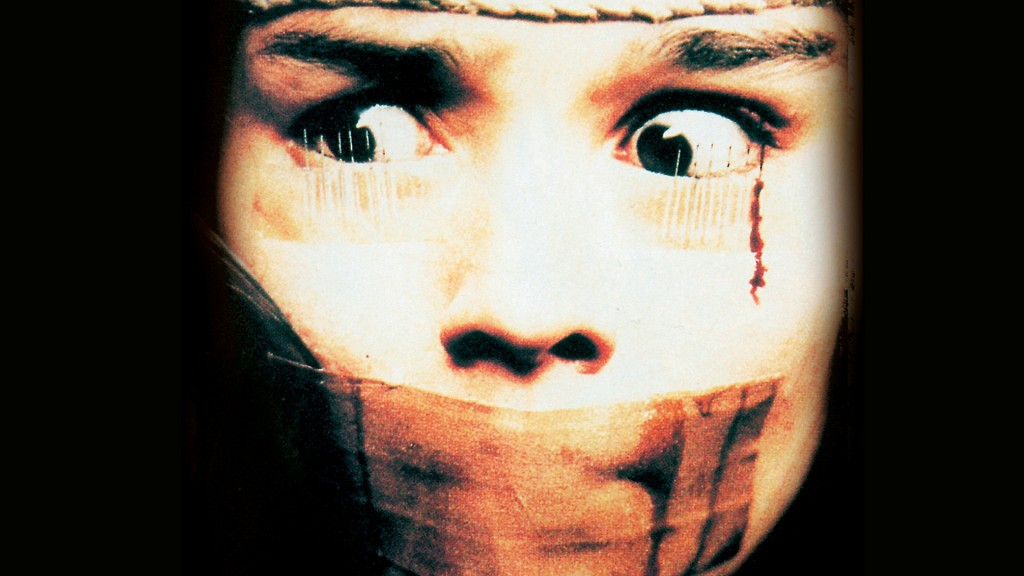Among horror fans, director Dario Argento’s name stands alongside some of the greatest of the genre. With Argento’s twenty-third feature, Dracula 3D, finally set for a limited North American release on October 4th, it seems a perfect time to introduce new readers to the filmmaker’s near forty year body of work and differentiate between his horror film classics and career missteps. Check out Part 1 HERE and Part 3 HERE
Deep Red (1975)
Rating: BUY IT NOW
After the disappointment of The Five Days of Milan, Argento reworked the best elements of his previous giallo flicks and used his fluid camera in an ever more arresting manner, resulting in what is arguably the finest film of his career. David Hemmings, the most talented actor to have appeared in an Argento movie yet, stars as a musician (shades of the hero in Four Flies on Grey Velvet) who witnesses a neighbor being murdered in her apartment from the street below. He races to the scene and knows he has seen a small detail crucial to solving the crime, but can’t quite figure out what it is (much like in The Bird with the Crystal Plumage). Helping him on the case is a driven reporter (similar to The Cat ‘O Nine Tails), played with oddball comedic flare by Daria Nicolodi. Nicolodi’s interplay with Hemmings is also charming, and the film even makes a point of commenting and criticizing sexist attitudes common at the time. Every shot is gorgeous, from macro roaming camera moves across items on a desk, to impressive crane shots and its outrageously elaborate, wince-inducing executions that include an impaling on glass, a hot water scalding and the beating of a character’s face against the side of a table. The murders themselves were wisely conceived to be brutal in a way that viewers could identify with and therefore possess greater shock value. The brutality and flashy camera showmanship even serves a purpose during the first slaying, distracting viewers from the killer’s identity, which is subtly, yet plainly visible onscreen. A wonderfully memorable bass guitar and keyboard heavy score from first time collaborators Goblin (Walter Martino, Fabio Pignatelli and Claudio Simonetti, who replaced original composer Giorgio Gaslini) helps maintain the suspenseful tone. It also features the best line of any Argento film; that of Hemming’s overly eloquent way of politely calling for help in his abode while being stalked by the maniacal, knife-wielding killer. “There’s someone in the house… absolutely trying to kill me, you know!” Now that is pure genius.

Suspiria (1977)
Rating: BUY IT NOW
Argento followed up the huge success of Deep Red with another experiment. This time, unlike the more jarring shift of The Five Days of Milan, it was both a critical and commercial success (resulting in a high profile international release, including distribution from 20th Century Fox in the US). Co-written by witch-lore enthusiast Daria Nicolodi, taking cues from fairy tales of old and bedtime stories relayed to him by his aunt, the director spun a wild and grotesque supernatural yarn with a unique visual style. Featuring bold Technicolor images that burst off of the screen like vibrant pages of an illustrated children’s book, this effort is gorgeous from its first frame in a neon-tinted German airport to its last as vibrant flames burst across the screen. In another wise casting move, likable American actress Jessica Harper stars as dance student Suzy Banyon, a young woman thrust into a conspiracy who must face a terrifyingly evil force living somewhere within the ornate dance academy. Once again, interpreting one’s own memory plays a part as a crucial bit of information is given to the lead in the midst of a raging storm. The exaggerated tone, breathtaking sets (the academy entrance looks like a glossy, remodelled take on Dracula’s castle) and fantasy thematic allow Argento to get away with a narrative that, unlike his giallo thrillers, doesn’t make a lick of sense. Even if you are a witch, who sets aside a room in a busy academy and keeps it full of sharpened wire? Thankfully, it doesn’t matter. Instead, horror fans will be treated to an incredible opening double-murder set piece and a dog attack featuring a wild overhead camera move, among many others. After a cringe-inducing encounter with maggots, there’s a surprisingly suspenseful sequence in which the main character is forced to sleep in the academy overnight and is placed a few feet away from the mysterious and vicious witch, hidden only by a thin sheet. Who says the best scares have to involve buckets of gore? The director wisely (whether he realized it at the time or not), alludes to two more still living witches in other locations, opening the door for further instalments. He later assigned this series the moniker of “The Three Mothers” trilogy.
Inferno (1980)
Rating: RECOMMENDED, BUT RENT IT FIRST
Following the international success of Suspiria, Argento moved on to another fantastic tale of a second evil witch, or perhaps, mother number two. As established in the first film, this antagonist is related to the German witch villain, but instead lives in fancy New York digs. Like Suspiria, the film is gorgeous to look at, with stunning set design and a vibrant blue and red colour scheme. There are animal references galore, including an attack by both an angry kitty and hungry rats. The nightmarish imagery is intact, as the female lead discovers a hidden underwater room and must plunge in to retrieve a dropped key. However, the story itself is slightly less involving than Suspiria for several reasons. Its narrative logic is almost non-existent, the events in this mystery even less clear than its forerunner. There’s also a discordant switch of protagonist midway through. While certainly startling, it does seem a little late in an already confusing game to introduce a new lead (played by Leigh McCloskey). And its big suspense set pieces seem a bit more drawn out, although they are still disturbing – characters plunge through windows, are impaled guillotine-style on a falling shaft of glass and have their throats slit. The music by Keith Emerson is suitably chilling, particularly during the startling (and frankly, dangerous looking) climax, which features a character change form as they burst jarringly through a mirror. While a solid and stylish effort, the movie itself is more impressive than engaging and feels maybe 10 minutes too long, all of which excludes it from classic status. 20th Century Fox, who distributed the film in the US, were more than a little confused by what they had on their hands, and reportedly were embarrassed to distribute it.
Tenebre (1982)
Rating: BUY IT NOW
This thriller, unmistakably 80’s in appearance, remains an appropriately disturbing murder mystery. Anthony Franciosa plays Peter Neal, a Stephen King-esque novelist on a book tour whose latest work appears to be inspiring a puritanical copycat killer. After the psychotic cruelly slaughters a young Italian woman (either for crimes against English language acting or stealing Neal’s book without paying, it initially seems), the maniac attempts to make contact with the author, involving the lead in the police case. Franciosa and John Saxon’s agent Bullmer are amiable leads, particularly when discussing Buller’s hat-wear and its inability to be knocked off of his head (obviously, there’s a subtle pay off later). Argento experiments with this thriller, using a cool color palette including icy blues and whites, a distinctive change of pace after Inferno’s explosive color scheme, but one that emphasizes the impact of the violent slayings. While not featuring as much fluid camera movement, the director’s distinctive style remains and the film contains a jaw-dropping technical feat; a single camera move which starts on a character looking out a window, then cranes up the side of a house and through a window into a bedroom, then backs out, continuing upward over the tiled roof and down the other side of the house before finally revealing the killer. This stunning two minute shot establishes the geography of the murder scene and characters within the location in an original way. The theme of memory again plays a significant role, as the director creatively uses childhood flashbacks to provide insight into the mind of the killer. Impressively, it is ultimately used to trick audience members into making a false assumption. This leads to a deliriously enjoyable climax with numerous twists, turns, surprise jolts (via camera placement) and four unforgettably vicious murders, including one of the bloodiest dismemberments of Argento’s career. I’d hate to be the guy who has to repaint those white walls! The story is also tighter, more logical and believable than most of the director’s efforts. Goblin members Moranti, Pignatelli and Simonetti supply the eerie (yet disco-esque) synthesizer score.

Phenomena (1985)
Rating: RECOMMENDED, BUT RENT IT FIRST
Somewhat underrated upon its release, this fairy-tale inspired effort marries incongruous elements in an exciting if not particularly plausible way. Get a load of this concept; a strange monster lurks in the hills of Switzerland, occasionally venturing out to dispose of young students at a nearby female academy. A very young Jennifer Connelly (yes, that Jennifer Connelly) stars as, well, Jennifer, the daughter of a famous American actor, enrolled for a year at a boarding school while her father finishes production on a movie in the Philippines (just what kind of Hollywood movie is this?). Jennifer has a close bond and psychic connection with insects, and is soon shunned by most of her schoolmates. She also has strange, tripped-out visions in her sleep that lead her to sleepwalk to the nearby home of Dr. John McGregor (Donald Pleasence) a Scottish, wheelchair-bound entomologist working for the police on the student slayings, and whose household nurse is a chimp named Tonga. Tonga seems friendly, but you don’t want to make her angry, a fact discovered in a deliriously enjoyable subplot that finds the chimp on a revenge-filled rampage. That is, before the ape renounces violence with a symbolic gesture at the film’s close (this is not a joke). Some of the varied music scoring cuts, like The Rolling Stones guitarist Bill Wyman’s cue are quite effective, while others seem bizarre and inappropriate (this film began the director’s strange penchant for using blaring heavy metal music). Thankfully, the excellent performances by Pleasence and a young Connelly are engaging enough that if you can shut all rationality off, the movie works. The effects work is ample, including a revolting, maggot-filled body pit and grotesque murders, the most notable including a thin, uncut sheet of steel that is used to decapitate a character unexpectedly. Best of all, Argento maximizes tension in simple scenes, including one in which Jennifer attempts to sneak out of the dormitory and not attract the attention of a nearby nurse. A sewing needle falls in slow motion, and the viewer winces before it lands safely and softly into a ball of yarn on the floor. Little scenes like this show a real desire to elevate suspense. And a big, unintentional plus is a story so crazy that you can never predict what’s coming next. However, for many, this tale was too baffling to make it successful on its original release. It didn’t help that at the time of release, US distributor New Line Cinema chopped nearly thirty minutes of footage out and re-titled the unintelligible remains Creepers.

Opera (1987)
Rating: BUT IT NOW
This ranks as perhaps Argento’s last certifiable classic, even if it does fall flat during its weak anticlimax. The tale involves an unknown masked killer who is obsessed with Betty (Cristina Marsillach), the pretty understudy in a new operatic production of Macbeth. Betty soon learns that this maniac claims to have had an unhealthy relationship with the young actress’s own mother. Not only that, but the person intends to renew the fetish with the young starlet by repeatedly tying up the poor girl, taping sharp needles under her eyes and forcing her to watch him committing horrendous crimes. Although Argento’s predilection during this era in his career to score slaughter scenes with cheesy metal tunes takes a bit of getting used to, the death scenes are still elaborately designed, upsetting and at times suspenseful. The first highlight occurs when the production’s costume designer accidentally swallows a revealing piece of evidence while being butchered, leaving the criminal only moments to desperately retrieve it with scissors. There’s just something about metal scissors clanging against teeth (or the sound design used to depict it) that sends chills down the spine. The second is so good it remains a highlight of the filmmaker’s career. Betty and her agent (played by Daria Nicolodi) find themselves stalked, but are unsure whether the person has left the apartment or not. A knocking comes and the two try to determine whether the figure on the other side of the door is trustworthy. This sequence ends with a phenomenal slow-motion close up of a bullet flying through a peephole, across a room and through a telephone (among other things). The film looks exquisite thanks to Oscar-winning cinematographer Ronnie Taylor. More visual highlights include the killer’s brain throbbing on camera and a sequence in which a crow is released into the opera to identify the killer and swoops over the crowd via an elaborate crane. Bloody and gruesome, the film moves quickly and only falters during its last five minutes. Reports have surfaced that claim Argento hadn’t quite figured out how to end this movie, only certain of the location and as a result had to improvise on the spot, leading to a weak wrap up of an otherwise first rate effort.


